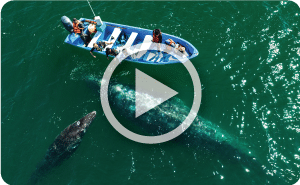In the beginning, there was a legend about 4 islands way out in the pacific, far from the shores of Baja, Mexico. The archipielago de Revillagedos. English pirates would shelter these islands to leap out and attack Spanish Manila galleons gliding down the coast to Acapulco, loaded with spices and treasures. Thousands of humpback whales gathered every winter to mate and breed. Clouds of giant mantas inhabited the waters around the islands year-round and the ocean was teeming with sharks, including those travelling the hammerhead shark highway from the Galapagos to Malpeldo, Cocos, Clipperton, Socorro, and then into the Sea of Cortez. Every 50 to 100 years, another volcanic eruption would hurl giant clouds of pumice and ash into the air or along the surface of the ocean. It was primal, raw, beautiful, remote, and visited only by a lucky few.
Baja Expeditions found Tim Means had long dreamed of running diving expeditions out to the legendary offshore archipelago. In 1978, his dream came true when he and Ted Waltham acquired the Baja Explorador, an ex-Alaska patrol and research boat at 120 feet long and 45 years old. This boat had recently starred in the film Lucky Lady with Liza Minelli, Gene Hackman and Burt Reynolds smuggling and drug running from Baja into the USA. With the fearless Captain Ted, his wife as well an expedition manager, 3 engineers, 3 cooks, and 3 deckhand/panga drivers onboard, they set out with 22 passengers on what turned out to be a 36-hour run to San Benedicto, the northernmost island in the archipelago. Equipped with private cabins for 2 or 3 guests, the ship stood heads and shoulders above any other dive boat of the 1970’s and the lack of air con didn’t bother anyone in the least. They simply slept on the open deck as the ship made its way south.
And wow, the diving was something else. Picture this, up to 3 dozen giant mantas on a single dive. And of course, in those days, nobody gave a second thought to riding a manta. It just seemed to be the thing to do, and the mantas kept coming back from more (we definitely no longer ride our giant mantas!!). Mantas gracefully swimming on the surface, jumping out of the water, and giant mantas 18 feet across playing high speed chicken with each other and only veering away at the last second. Reportedly, if the mantas didn’t want to engage with divers, they simply swam away. Film shot in those days shows divers doing “intimate things” with mantas that we would never consider in this day and age. Cost?? Around $2000 per person for a unique adventure to the edge of the known diving universe of the 1970s.
Fast forward to the 1990s and BajaEx’s next boat. The 72-foot sailboat Copper Sky. This might not have been the best decision we ever made at BajaEx because, while the Copper Sky might be many things, it was not a good dive boat. It was small, crowded, no privacy, rolly, diesel exhaust smell, and no dive deck. The cost of these trips had increased to $2695, and while there were still plenty of giant mantas in the Islas, the impact of industrial-scale fishing had already taken a toll on the local shark population.
Just after the turn of the millennium, Tim persuaded Captain Mike to bring the Nautilus Explorer down from Canada to run trips out to Socorro under the flag of BajaEx. With a keen eye on marketing, the islands were rebranded as “Socorro” (the largest island of the archipelago) as it was far easier to pronounce and sell than the Red-vee-ahhh-hah-hey-does!! Mike immediately dropped the price of the trips to $2250, and the Explorer brought a new level of luxury and a consistent departure schedule to Socorro adventures. With air-conditioned staterooms and suites with individual bathrooms and showers, chef-prepared food, hostesses, a hot tub, and even a full selection of single malts, port, craft beer, and wine list. The diving unfortunately was at its nadir because of fishing pressure. Divers were lucky to see giant mantas on one or two days of each trip. There were sharks but not very many of them. Some days were kind of boring but other days were really special, especially when friendly dolphins or humpback whales showed up. The start of the season would see teams of divers clearing abandoned nets from the reefs and shoreline and aggressive confrontations with illegal fishermen. Nautilus had the entire archipelago to themselves other than sharing with just one other pioneering boat, the Solmar V.
2024 and what’s it like now?? Well, frankly, the diving is once again superb, glorious, and beautiful. The flourishing number of animals on the island is a testament to our efforts alongside Mike McGettigan and the government of Mexico in driving away the illegal fishermen. The tide turned for sure in 2006 when the President of Mexico committed to protecting these islands after a gill netting incident at the Boiler that we filmed and was shown on nightly televisa across Mexico. Being in the water is so great now. Mantas everyday and often on every dive. Loads of sharks and pelagics, huge schools of fish, and super playful dolphins. It is a rare gift to be able to experience this oasis. Read below for what our guests have been saying over the last month. And the price?? 20 some odd years later, a 9-day 8-night trip is in the mid-3000s. We hope you can join us.
Captain Mike
Founder












